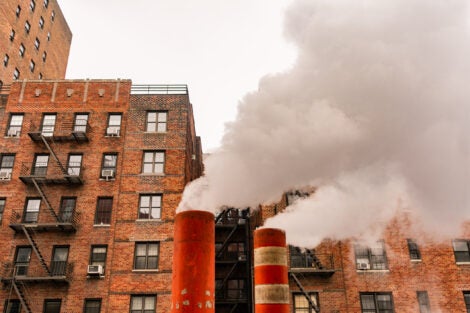January 24, 2024—Matthew Shupler, postdoctoral research fellow in the Department of Epidemiology at Harvard T.H. Chan School of Public Health, recently led a study investigating the association between exposure to fine particulate matter (PM2.5) found in outdoor air pollution and risk of stillbirth. The study, published in American Journal of Epidemiology, also examines racial and socioeconomic disparities in this association.
Q: Tell us about the study’s objectives and findings.
A: We wanted to examine if there is an association between sudden spikes in air pollution—specifically PM2.5—and the event of a stillbirth. We also wanted to find out if race and socioeconomic status play a role in the level of the association, especially given that pollution sources, from power plants to traffic, are distributed so inequitably in the United States.
There hasn’t been a lot of large-scale research looking at the relationship between short-term exposure to air pollution and stillbirth risk; most studies have averaged individuals’ air pollution exposure over the course of their entire pregnancy. Additionally, sparse air monitoring data has prevented the use of more granular-level data on individuals’ air pollution exposures.
To overcome this, we used data on daily averages of PM2.5 and other air pollutants at one square kilometer resolution. The database was created by researchers in the Department of Environmental Health who combined machine learning techniques with measurements from Environmental Protection Agency (EPA) air monitors, satellites, and other sources. We linked this data to zip-code level data from Medicaid claims of stillbirths from nearly 120,000 people between 2000 and 2014. Linking the two data sets enabled us to estimate PM2.5 levels in the days and weeks surrounding a stillbirth, helping us understand the association between the two.
Across the entire study population, we didn’t observe any significant association between sudden increases in PM2.5 and stillbirth. However, when we stratified the data by race/ethnicity, we saw a significant association specifically among Black individuals. Pregnant Black individuals had an increased risk of experiencing a stillbirth due to an increase in PM2.5 concentration during the week prior to stillbirth. When we examined the results according to median household income at a zip-code level, we found the association to be even stronger among Black individuals living in the lowest income zip codes.

Q: Were you surprised by these findings?
A: We know from other environmental justice research that racial minorities and low-income individuals are often disproportionately exposed to environmental hazards such as air pollution and usually more vulnerable to negative health outcomes. So it wasn’t surprising to identify the disparities by race and socioeconomic status that we did. Our findings reinforce the need for more investigation into how other factors, like stress and access to health care, are potentially helping shape the association we observed.
Q: What are the study’s other takeaways?
A: We can see from the study that regulations on air quality in the United States might not be tight enough. The EPA’s current outdoor air quality standards state that annual average concentrations of PM2.5 should not exceed 12 micrograms per cubic meter of air. Most of the PM2.5 concentrations in our study were well below that and we still observed a link to stillbirth among Black individuals in the U.S. It’s true that for a single individual, the odds of experiencing a stillbirth after a short-term episode of increased PM2.5 are low. However, since everyone is exposed to air and is breathing in this pollution, the risk of stillbirth due to sudden spikes in air pollution becomes an important public health concern, especially for already marginalized populations. To potentially help reduce stillbirth risk, policymakers should consider reducing our country’s standard for PM2.5 and educating the public about the elevated risk of stillbirth during high pollution episodes, such as wildfire events. Equipped with this information, pregnant individuals should aim to spend more time indoors during periods with elevated PM2.5 levels to possibly help lower their risk of stillbirth.
Photos: Smokestacks: iStock/James Andrews; Shupler: Courtesy of Matthew Shupler
